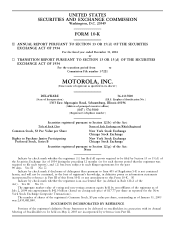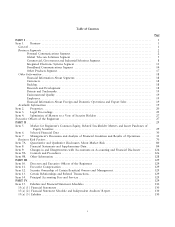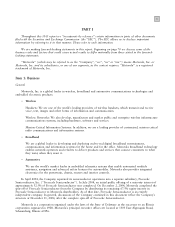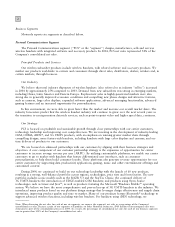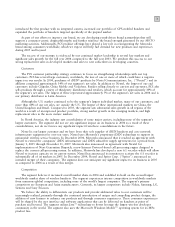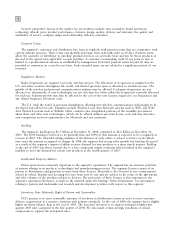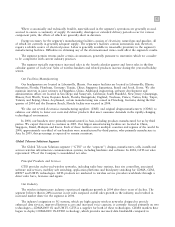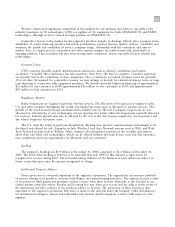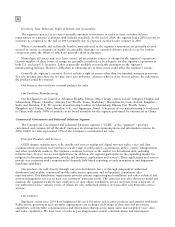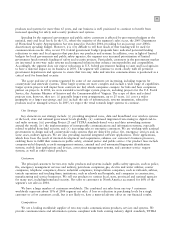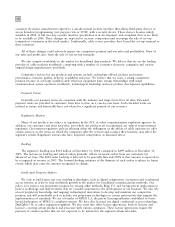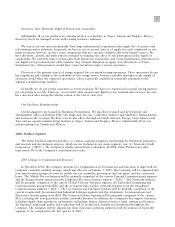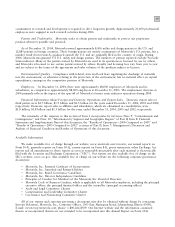Motorola 2004 Annual Report Download - page 17
Download and view the complete annual report
Please find page 17 of the 2004 Motorola annual report below. You can navigate through the pages in the report by either clicking on the pages listed below, or by using the keyword search tool below to find specific information within the annual report.
9
products and systems for more than 65 years, and our business is well positioned to continue to beneÑt from
increased spending for safety and security products and systems.
Spending by the segment's government and public safety customers is aÅected by government budgets at the
national, state and local levels. In the U.S., where the majority of the segment's sales occur, the 2005 Department
of Homeland Security Appropriations Act was passed in October 2004, providing for an increase over 2004's
discretionary spending budget. However, it is very diÇcult to tell how much of that funding will be used for
communications needs. Also, recent U.S. federal government budget proposals have indicated potential funding
reductions to state and local agencies that purchase our products and systems. In addition, even in light of limited
budgets for local governments and public safety agencies, the segment sees increased prioritization of limited
government funds towards funding of safety and security projects. Particularly, customers in the government market
are interested in two-way radio systems and integrated solutions that enhance interoperability and compatibility.
Accordingly, the segment does not expect reductions in U.S. federal government funding to state and local agencies
to have a material impact on its business in 2005. The segment will continue to work closely with all pertinent
government departments and agencies to ensure that two-way radio and wireless communications is positioned as a
critical need for homeland security.
The scope and size of systems requested by some of our customers are increasing, including requests for
countrywide and statewide systems. These larger systems are more complex and include a wide range of capabilities.
Larger system projects will impact how contracts are bid, which companies compete for bids and how companies
partner on projects. In 2004, we were awarded several larger system projects, including projects for the U.S. Postal
Service, the Austrian Ministry of Interior and the Commonwealth of Virginia. The scope of these and related
projects vary, however, they are: (i) generally longer term arrangements, up to 25 years, (ii) cover a wider
geography or a larger user group, and (iii) include the sale of infrastructure, systems integration, subscriber
products and/or managed services. In 2005, we expect the trend towards larger systems to continue.
Our Strategy
Key elements in our strategy include: (i) providing integrated voice, data and broadband over wireless systems
at the local, state and national government levels globally; (ii) continued migration from analog to digital end-to-
end radio systems; (iii) providing Project 25 and TETRA standards-based voice and data networking systems
around the world; (iv) the implementation of interoperable communications and information systems, especially
related to global homeland security; and (v) increasing sales to enterprise customers. We are working with national
governments to design and sell countrywide radio systems that are shared by police, Ñre, emergency services and, in
some cases, military agencies. We are also providing essential integrated software applications. These applications,
which have been the result of internal development and acquisitions, enhance our customer's business processes,
enabling them to fulÑll their missions in public safety, criminal justice and public service. Our product lines include
computer-aided dispatch, records management systems, criminal and civil automated Ñngerprint identiÑcation
systems, mobile data applications and devices, corrections management systems, and customer service request
systems, as well as other related products.
Customers
The principal customers for two-way radio products and systems include: public-safety agencies, such as police,
Ñre, emergency management services and military; petroleum companies; gas, electric and water utilities; courier
companies; telephone companies; diverse industrial companies; transportation companies, such as railroads, airlines,
taxicab operations and trucking Ñrms; institutions, such as schools and hospitals; and companies in construction,
manufacturing and service businesses. We sell our products to various local, state, provincial and national agencies
for many uses, including homeland security. Net sales to customers in North America accounted for 66% of the
segment's net sales in 2004.
We have a large number of customers worldwide. The combined net sales from our top 5 customers
worldwide represent about 11% of 2004 segment net sales. A loss or reduction in purchasing levels by a single
customer or a few customers could, but is not likely to, have a material adverse eÅect on our Ñnancial results.
Competition
We are a leading worldwide supplier of two-way radio communications products, services and systems. We
provide communications and information systems compliant with both existing industry digital standards, TETRA


